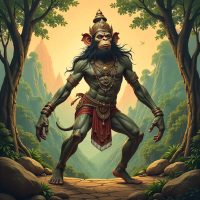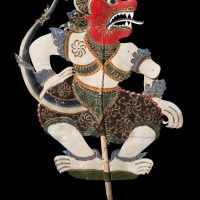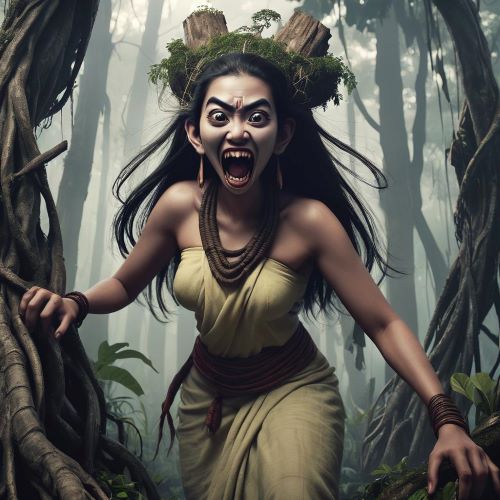Handuman : The Vanara Hero of the Malay Ramayana
Listen
At a glance
| Description | |
|---|---|
| Origin | Malaysian Mythology |
| Classification | Hybrids |
| Family Members | N/A |
| Region | Malaysia |
| Associated With | Strength, Size, Loyalty |
Handuman
Introduction
Handuman remains one of the most compelling figures in the Hikayat Seri Rama, the Malay adaptation of the Indian Ramayana. While the core storyline mirrors the ancient Indian epic, the Malay retelling reshapes characters to align with local values, aesthetics, and spiritual ideas. In this cultural landscape, Handuman—known variously as Hanoman, Andoman, or Anoman—takes on a richly expanded role. More than Rama’s devoted ally, he becomes a symbol of agility, intelligence, and divine intervention within the Malay imagination. The Hikayat often highlights his cleverness and loyalty to Seri Rama and Laksmana, blending Indian mythological roots with Southeast Asian performance traditions. Through this adaptation, Handuman emerges not only as a heroic vanara but also as a bridge between the human and supernatural worlds, embodying virtues cherished in both Indian and Malay folklore.
Physical Traits
Handuman’s physicality in the Hikayat Seri Rama reflects both Indian iconography and Southeast Asian artistic evolution. Descriptions emphasize his simian features—his expressive monkey-like face, elongated limbs, and agile body—symbolizing his ability to move fluidly between realms. Malay wayang kulit (shadow-puppet theatre) often portrays him with a stylized white or pale body, a color associated with purity, spiritual authority, and divine strength in local storytelling traditions. His long tail, radiant expression, and muscular frame reinforce his role as a heroic warrior capable of astonishing feats. Unlike Indian depictions, which frequently portray him with fiery colors linked to his energetic nature, Malay renditions adopt more graceful aesthetics, aligning him with refined performance traditions. His iconic mace, though sometimes simplified in puppet designs, remains a symbol of his unmatched martial prowess.
Family
Although Handuman’s lineage in the original Ramayana is elaborate—born to Anjana and Kesari, with the wind god Vayu facilitating his divine birth—the Hikayat Seri Rama places less emphasis on celestial parentage. While his Indian origins remain acknowledged in broader Southeast Asian tradition, Malay adaptations shift focus from ancestry to duty. In the Hikayat, his “family” is defined through unshakeable loyalty to Seri Rama and Laksmana, portraying him as a spiritual son and devoted guardian rather than a figure shaped by divine genealogy. This localized interpretation highlights relational bonds over mythic lineage, aligning with Malay storytelling values that elevate loyalty, service, and moral integrity as defining virtues.
Other names
Across Southeast Asia, Handuman’s name evolves as the Ramayana travels through cultural and linguistic landscapes. In Malaysia and Indonesia, he is widely known as Hanoman, a Javanese-influenced name that became prominent through wayang kulit and literary traditions. Earlier Malay manuscripts refer to him as Andoman or Anoman, demonstrating how oral and written traditions adapted foreign names to local phonetics. His Indian epithets—such as Maruti, Pavanputra, or Bajrangbali—are less common within Malay literature but remain widely recognized in Indian communities across Malaysia. These variations illustrate the flexibility of myth as it moves across cultures, preserving the essence of the hero while allowing the name to evolve naturally within new linguistic environments.
Powers and Abilities
Handuman’s abilities in the Hikayat Seri Rama closely parallel those found in the Indian epic but are often dramatized for performative storytelling. His immense strength allows him to overpower demons and hostile forces, underscoring his role as a formidable warrior. His capacity to change size—from tiny and unseen to colossal and overwhelming—plays an essential role in espionage and battle strategies. The Malay tradition, strongly influenced by Javanese performance culture, often portrays him as a clever trickster whose wit outshines even the strongest enemies. His ability to leap across oceans, fly through the sky, and enter supernatural realms signifies his divine empowerment and connection to the cosmic order. Above all, his unwavering devotion to Seri Rama fuels his courage, making him a figure of moral purity whose power stems from absolute loyalty and righteousness.
Modern Day Influence
Handuman’s presence in Malaysia today extends far beyond literary tradition. The Hikayat Seri Rama continues to be performed in wayang kulit Kelantan, where Handuman is often one of the most dynamic and entertaining characters on stage. His acrobatic movements, humorous exchanges, and vibrant personality make him a favorite among audiences, mirroring the Malay appreciation for spirited storytelling.
In Malaysian Hindu communities, Handuman remains a deeply revered deity, celebrated during festivals such as Hanuman Jayanti. Temples across the country feature statues and shrines dedicated to him, reinforcing his spiritual significance. Outside religious contexts, his image appears in cultural murals, classical dance choreography, academic discussions on comparative mythology, and school literature exploring Southeast Asia’s shared narrative heritage. Handuman also inspires Malaysian artists and scholars as a symbol of courage, moral clarity, and transcultural connection. His role in bridging Indian and Malay traditions demonstrates the enduring power of myth to adapt, unite, and inspire across generations.
Related Images
Source
Beauty of Sree Veera Hanuman Temple, Brickfields. (2023, June 30). Varnam Malaysia. https://varnam.my/78029/the-beauty-of-sree-veera-hanuman-temple-brickfields/
Different Truths. (2025, September 18). Focus: Global Hanuman’s cultural impact across Southeast Asia. https://www.differenttruths.com/focus-global-hanumans-cultural-impact-across-southeast-asia/
High Emporium. (2025, March 10). Top 20 most important powers of Lord Hanuman. https://highemporium.com/blogs/history-and-religion/top-20-most-important-powers-of-hanuman
Mystery World Akshay. (2024, February 11). How actually Hanuman looks? https://mysteryworldakshay.com/how-actually-hanuman-looks/
The Gaudiya Treasures of Bengal. (2023, August 26). Story of Hanuman – The monkey god’s birth and history. https://thegaudiyatreasuresofbengal.com/2023/08/26/story-of-hanuman-the-monkey-gods-birth-and-history/
Vyas, S. (2021). Ramayana across Southeast Asia. Journal of Southeast Asian Studies, 52(2), 215–232. https://doi.org/10.1017/S0022463421000254
Shellabear, W. G. (1917). Hikayat Sri Rama. Journal of the Straits Branch of the Royal Asiatic Society. Retrieved from https://archive.org/details/biostor-176311
Lutgendorf, P. (2007). Hanuman’s Tale: The Messages of a Divine Monkey. Oxford University Press.
Brockington, J. (1998). The Sanskrit Epics. Leiden: Brill Academic Publishers.
Doniger, W. (2009). Hindu Myths: A Sourcebook Translated from the Sanskrit. Penguin Classics.
Narayan, R. K. (2006). The Ramayana: A Shortened Modern Prose Version of the Indian Epic. Penguin Classics.
Winstedt, R. O. (1925). Malay Folklore and Legends. Singapore: Kelly & Walsh.
Frequently Asked Questions
Who is Handuman in the Hikayat Seri Rama?
Handuman is a central heroic character adapted from the Indian Ramayana, portrayed in Malay tradition as a divine vanara known for bravery, intelligence, and loyalty.
Why is Handuman sometimes called Hanoman or Andoman in Malaysia?
Southeast Asian languages adapted his name over time, with “Hanoman” becoming common through Javanese and Malay storytelling traditions.
What powers does Handuman have in Malay mythology?
He possesses immense strength, the ability to change size, supernatural agility, great wisdom, and the capability to leap or fly across vast distances.
How is Handuman depicted in Malay wayang kulit?
He is shown with a stylized white body, elongated limbs, and expressive features that highlight agility and divine purity.
Does Handuman still influence Malaysian culture today?
Yes, through wayang kulit performances, temple worship, visual art, literature, and cultural festivals where he is celebrated as a symbol of courage and devotion.







